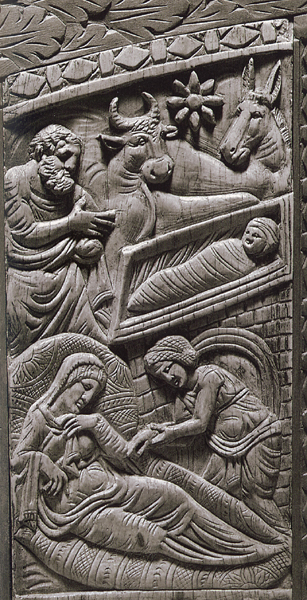Image Details

Museo Arcivescovile, Ravenna
The Nativity. The most famous (infamous?) scene from the Infancy Gospel of James—Salome’s test of Mary’s virginity—appears in the bottom half of this ivory inlay, which decorates the elaborate cathedra, or chair, of the sixth-century Byzantine bishop Maximianus. Doubting that a virgin could give birth, Salome “inserted her finger into Mary.” She then cried out, “I’ll be damned because of my transgression and my disbelief My hand is disappearing! It’s being consumed by flames” (James 20:2–4). In the ivory, Salome displays her withered hand before the Virgin.
The scene is extremely uncommon in art, perhaps because it was considered in bad taste. Salome herself does not disappear from church art, however, which emphasizes her repentance and conversion by including her as one of the midwives who bathe infant Jesus in nativity scenes.
The top half of the ivory also draws on the Infancy Gospel of James. Many art historians identify the cramped, rocky interior space as the cave where Jesus is born (James 18–20). The star in the sky is likely not the beacon that the magi followed but the bright light Joseph sees emanating from the cave after the birth (James 19:15–16). The ox and the ass, virtually omnipresent in nativity scenes, are borrowed from the Gospel of Pseudo-Matthew 16.
